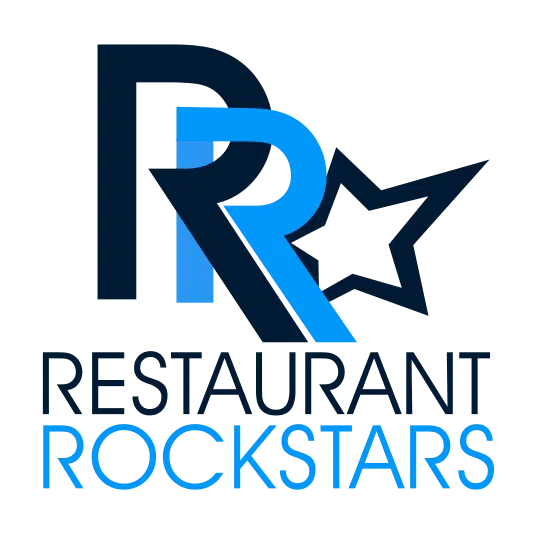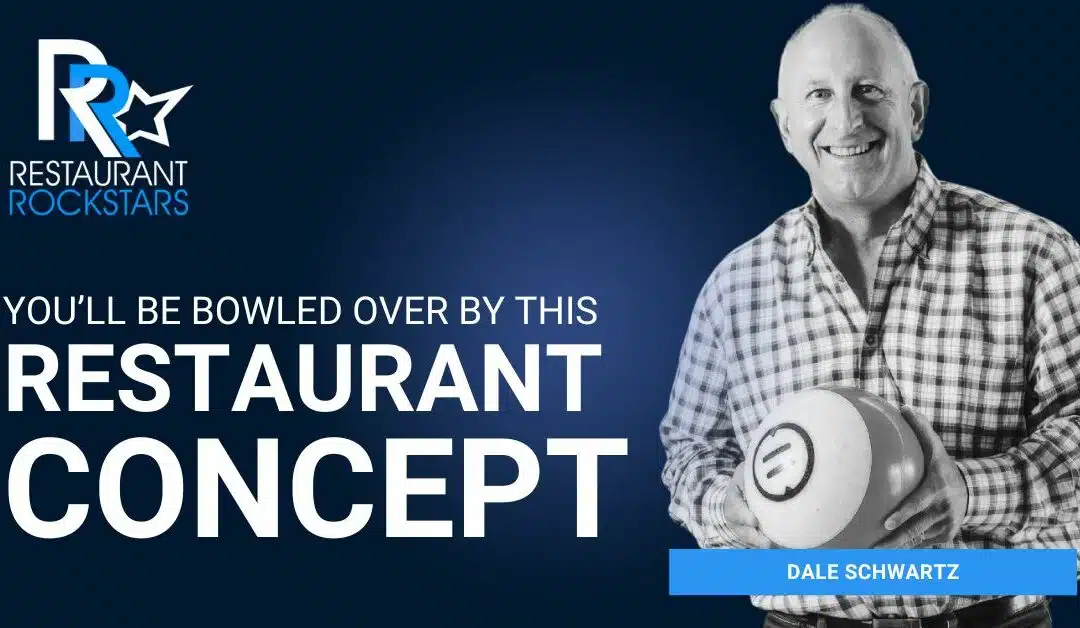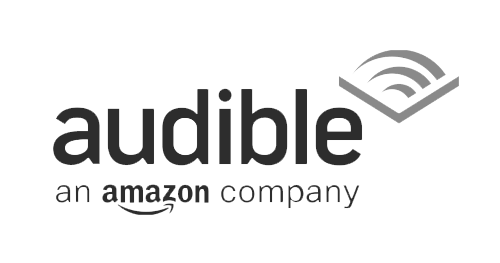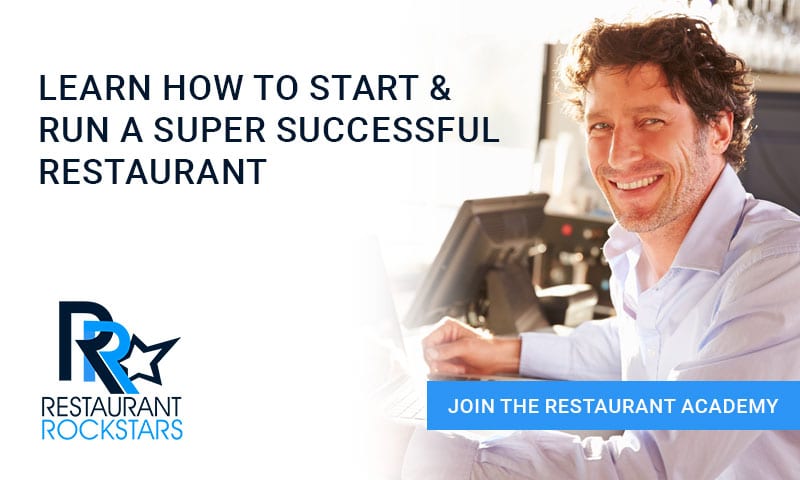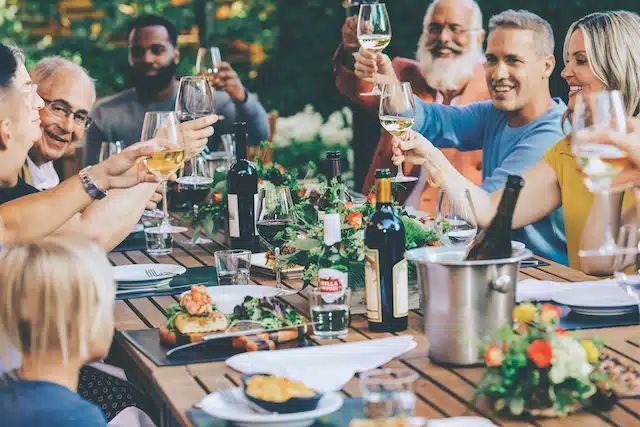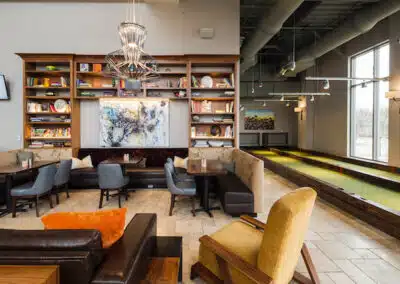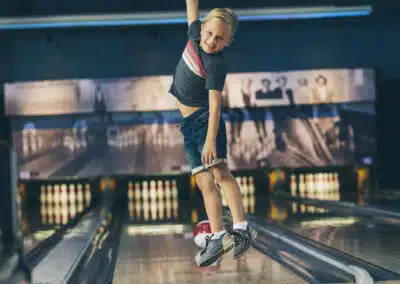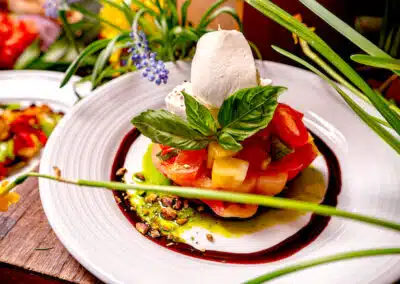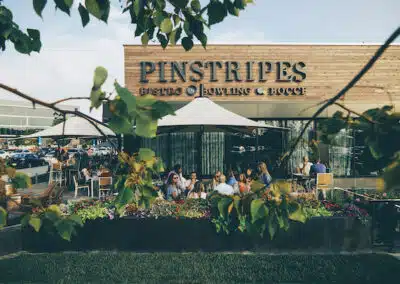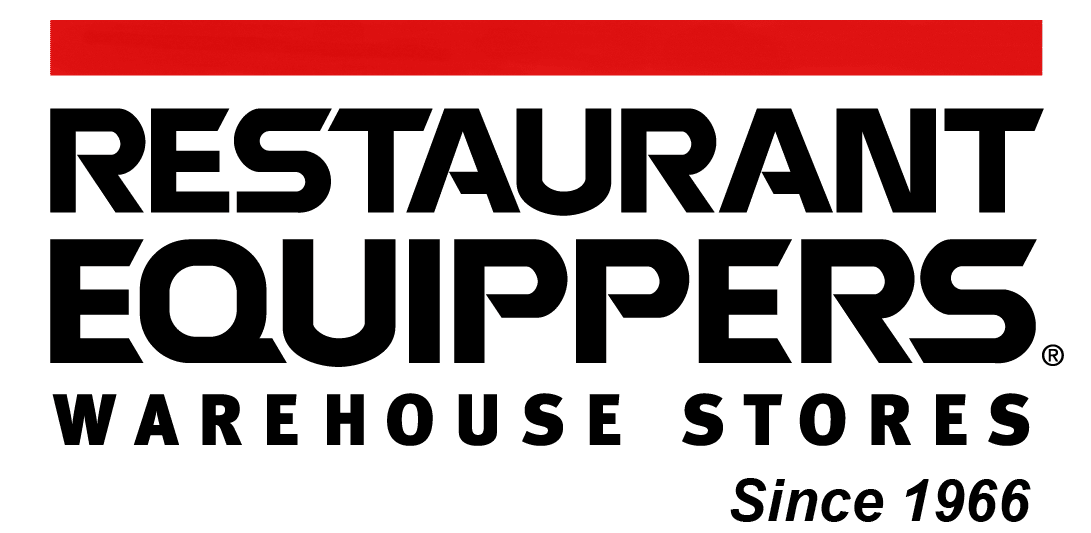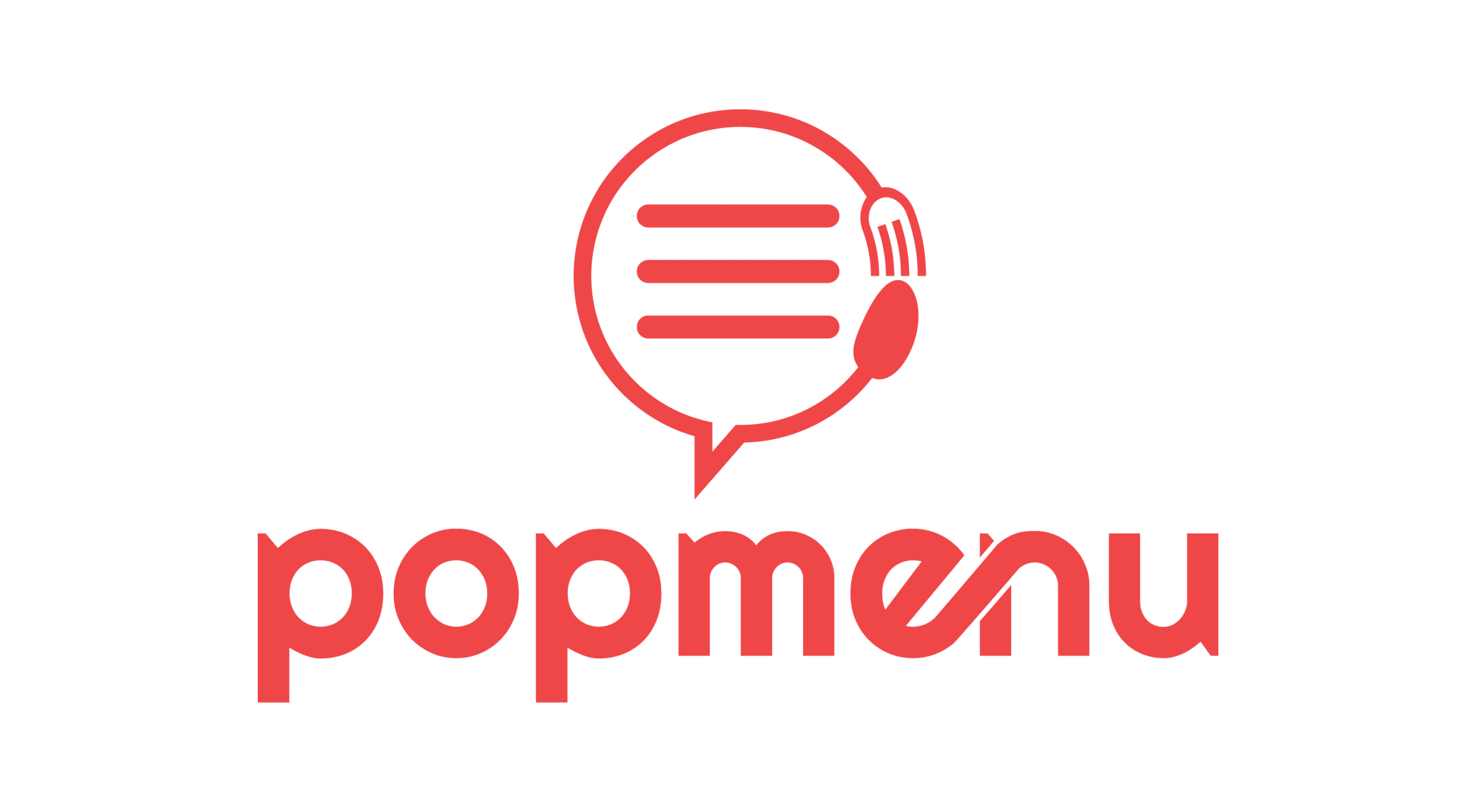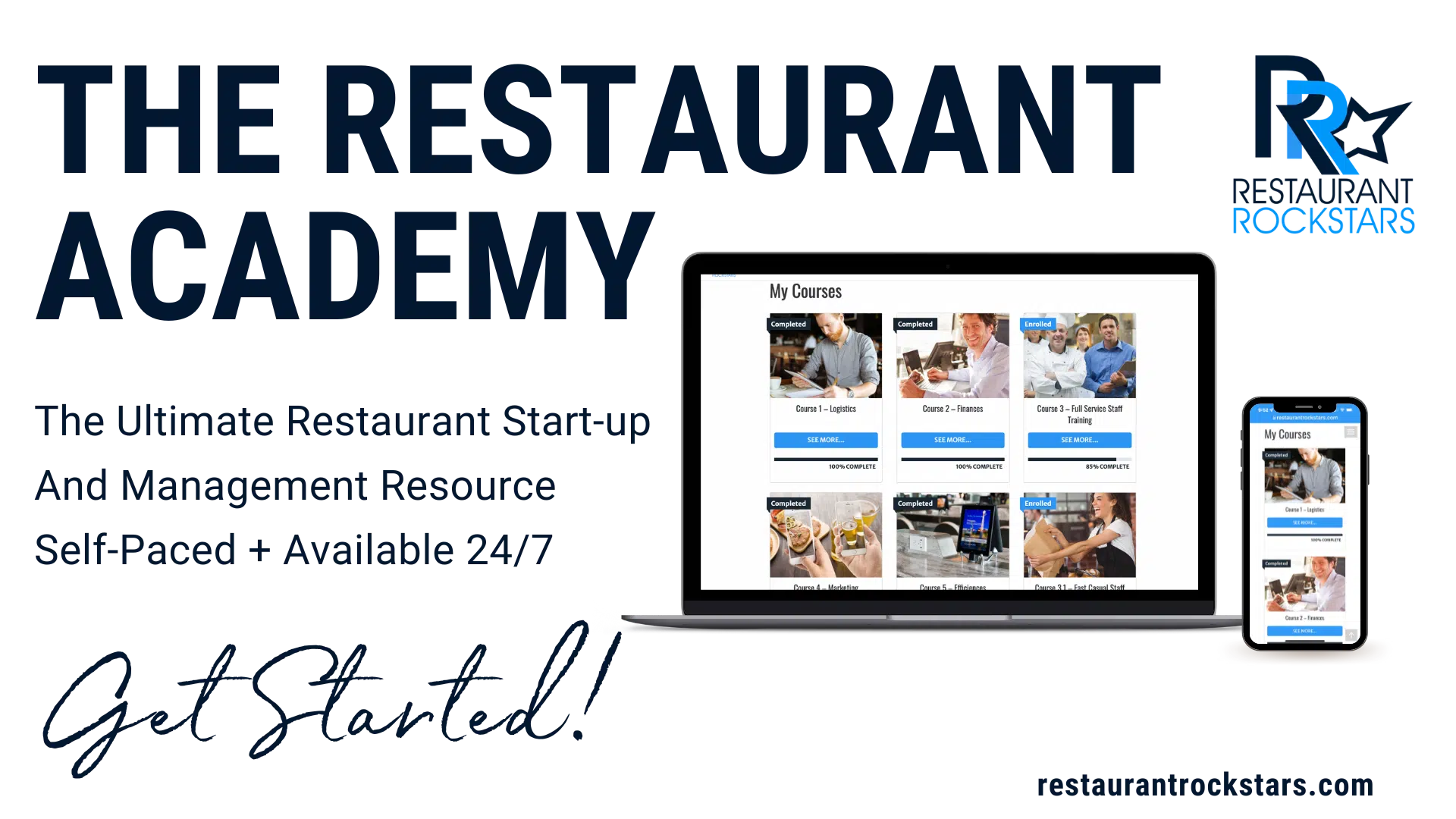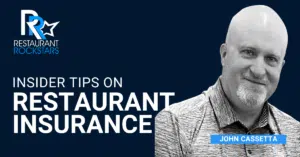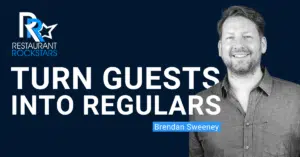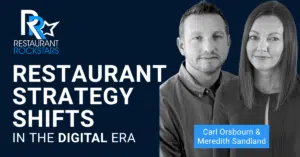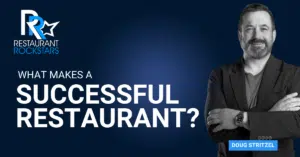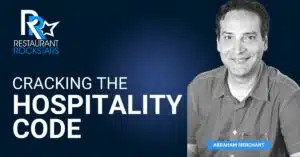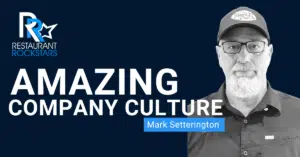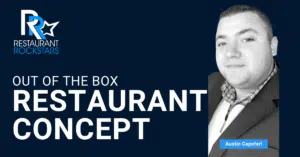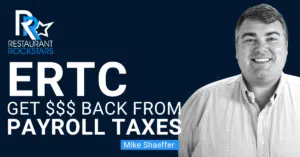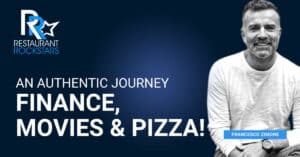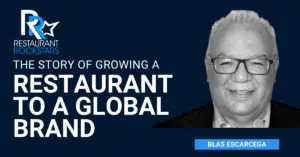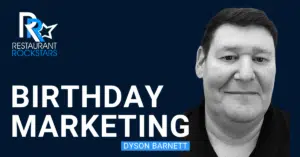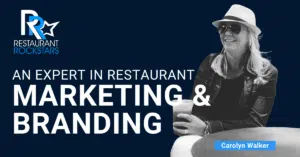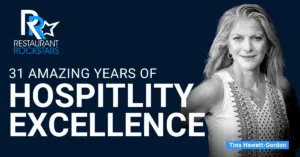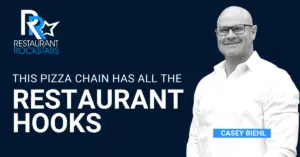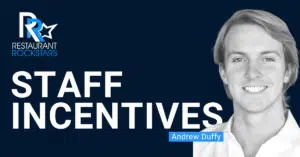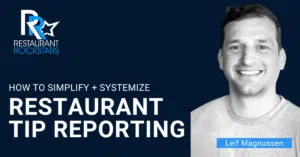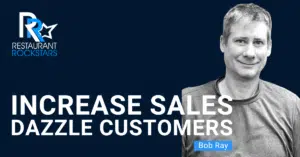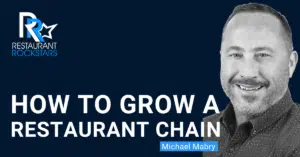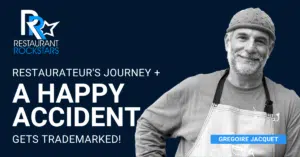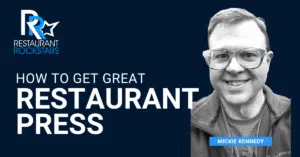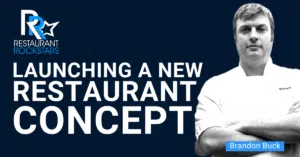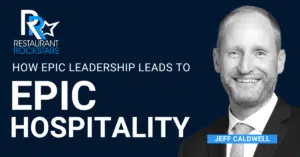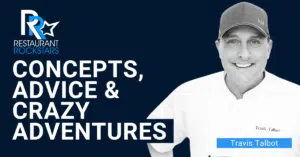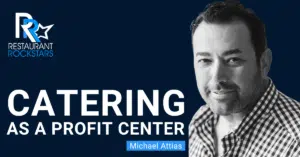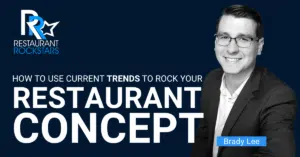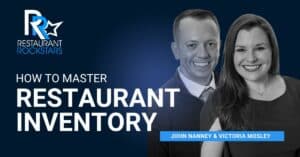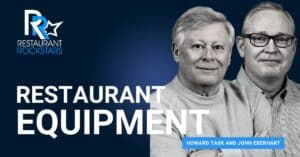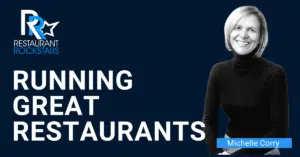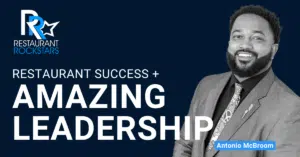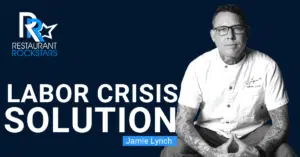Restaurant Rockstars Episode 384
Fun Restaurant Concept Will Bowl You Over!
LISTEN HERE OR ON YOUR FAVORITE PODCAST PLAYER
This business is all about “SHOW BIZ” and this hot concept will bowl you over!
Guests don’t just come into a restaurant for food & drink, they’re looking for an experience.
In this episode of the Restaurant Rockstars Podcast, I’m speaking with Dale Schwartz, CEO & Co-Founder of Pinstripes.
This restaurant concept boasts giant spaces for bowling, bocce, delicious bistro dining, events, and fun.
These restaurant concepts are as large as 30,000 square feet on multiple levels. Not every restaurant and bar has this much space, but the ideas here can spark ideas of how to capture more guests and keep them spending money.
Listen as Dale shares golden nuggets of wisdom about his restaurant concept including:
- His approach to running a business, not restaurants.
- The importance of “FUN FACTOR” for revenue, repeat business and buzz in the marketplace.
- Why size can be a competitive advantage.
- Essential and foundational brand-building
- Creating a hospitality culture that “Wows” the guest
- Effective leadership, staff training and recognition
- Influencer marketing that drives business
Whether you’re running a single location or building a national chain, Dale’s experience and approach to the restaurant business is a great listen!
Don’t miss this episode!
Listen, would you spend less than the cost of a fancy beer on boosting your restaurant profit?
That’s right for just $7, our Restaurant Profit Maximizer course will show you proven ways to boost profit in your restaurant. https://restaurantrockstars.com/sp/restaurant-profits
Check it out and then go Rock YOUR Profits and YOUR Restaurant!
Roger
Connect with our guest:
Hey there. Thanks so much for joining me on the podcast today. For those of you who follow this regularly, you know that I’m a huge believer in running a business, not running a restaurant and building a powerful brand. Well, today’s guest, Dale Schwartz is the CEO and co founder of Pinstripes, a large, When I say large, 30, 000 square foot venues that are all around bowling and bocce, Italian American food to perfection and providing real experiences.
And it is all about running a business. I’m speaking with Dale about so many things. We’re going to be talking about finances. We’re going to be talking about leadership, accountability, brand building, concepts, marketing. That is proven to work. That’s trackable. It covers a lot of ground. You’re not going to want to miss this.
Plus, Pinstripes is growing huge. You know, it was amazing. I was on my way to the New York City food show this past weekend and I drove by a Pinstripes concept and it just jumped out at me as a fun place to go. And they’re covering all the bases. So you’re not going to want to miss this episode. Thanks so much to our audience and sponsors.
And if you haven’t already, please check out the show notes to this week’s episode. We have something that is called the Profit Maximizer. And for less than the cost of a craft beer, for seven bucks, you can get some immediately actionable, proven ideas to increase the profit in your restaurant or hospitality business.
So check that out in the show notes and on with this week’s episode. Enjoy.
You’re tuned in to the Restaurant Rockstars Podcast. Powerful ideas to rock your restaurant. Here’s your host, Roger Beaudoin.
Rockstars, this year, give your team the gift of PopMenu AI Answering, a simple solution for phones ringing off the hook. AI Answering handles calls 24 7, 365 days a year, so your staff can focus on in person guests.
Customize your greetings and responses. Answer common questions. promote specials and events, and send follow up links to ordering and reservations. AI answering handles it all, while escalating more complex conversations back to your team. Now, never miss another tasty revenue opportunity. PopMenu is the marketing technology platform designed to make growing your restaurant easy.
Discover more AI restaurant tools that turn your to do list into an already done list. Request a demo today and my listeners for a limited time will get 100 off their first month, plus lock in one unchanging monthly rate. Go now to popmenu. com slash rockstars. Again, get 100 off your first month at popmenu.com/rockstars.
Listen, from one restaurateur to another, and I hope you GMs out there listening as well are paying attention, , marketing should never be an experiment, oh, I tried this or I tried that, no, any of your valuable dollars that you spend on marketing should absolutely be trackable, you should know exactly what you’re doing.
where the business is coming from, and that it’s driving return on your investment. You spend a certain amount of money, you want to make far more money in return from that marketing, if you can track it. So pay attention. My friend Dyson runs a business called The Birthday Club, and his program is done for you.
Because we know that everybody dines out on their birthday. It’s a tradition. It’s a celebration. But not only do they not come in by themselves, they bring many friends with them. They usually have free spending and large check averages. It’s very profitable business. So why leave it to chance? Why let your competitors get all the birthday business?
So again, the birthday club is a done for you program. All you have to do is check out www. thebirthdayclub. com. Jointhebirthdayclub.com/birthdayRockstar. It’s a great program. If I still owned and operated restaurants today, after decades, it’s something I would definitely be doing, it’s worth checking out.
Jointhebirthdayclub.com/birthdayrockstar.
Welcome back everyone to the Restaurant Rockstars podcast. So glad to have you here. Dale, welcome to the show. How are you today? Terrific. Terrific. You’ve got a very exciting, fast growing concept, and we’re going to talk all about that. But before we do, please tell us your hospitality backstory.
Where did it all start for you? And you can take us back as far as it goes.
Sure. Actually, so I’ll take it back six years to Cleveland. Grew up in Cleveland. bowled day. Kid always enjoyed it. Played football, went to Colgate. So I initially after business school I spent four years in Manhattan with a private equity group and was enjoying it, but certainly wanted to get back to the principal side.
I had started an asphalt business when I was 17 in Cleveland and always tasted the entrepreneurial side. I was going to buy a bowling alley in 1980. nine on the Upper West Side and coined the name Pinstripes in 1989, bowling pin, pinstripe suit. Myself and a couple of friends, we were going to do a bowling alley with quality upscale food and do it different and right and didn’t do it.
I got busy and then I left New York, traveled went back to Europe and elsewhere and then, After starting a pharmacy business that was combining prescription products with homeopathy, et cetera I kept mentioning for 10, 15 years, this pinstripes idea and finally said life’s too short almost 20 years ago now and spent two years putting all the pieces together to start pinstripes.
And we’ve been at it for almost 18 years now and we’ll talk about it, but that’s the summary backstory.
Wow. So you’ve got varied experience as well as business skills. And that made all the difference for me. I applied business skills to a business that is not traditionally run by MBAs and a lot of people run restaurants, but they don’t necessarily run businesses.
And that’s a paradigm shift. It’s a mindset shift, , I just came back from New York city. This past weekend, I was speaking at the international restaurant and food service show at the Javits Center. And. Ironically, I knew this was an upcoming podcast episode, and we were visiting a friend in New Jersey last Saturday, and I drove through Paramus, and there’s Pinstripes, and I’m like, wow, how ironic, there it is, and it’s right next to the highway, and it was this big building, and it looked so appealing from the road, and I had a very , general idea of what it was all about.
We’re going to dive into, the concept a little bit more, but I thought that was a little ironic. But anyway, thank you very much for sharing that story. When I owned restaurants, I didn’t run a restaurant, I ran a business, But my products were not food and drink.
They were entertainment, consistency, and a whole lot of good times. And I know that’s what Pinstripes is delivering. Let’s talk about some of the key learnings that early in your career, regardless of the industry, that made a difference for you that you’ve applied to this concept.
Key learnings that goes back a number of years certainly you have to have a passion for what you do.
So part of the magic of Whole Foods Back in the early days, where the team members cared about food, Home Depot, what Bernie Marcus and Arthur Blank did, they hired tradesmen that cared about lumber and nails, etc. And that matters. In our case I mean, we, I stole the term from the former CEO of Trader Joe’s, John Shields.
When we hired Team members we tell a lot of our team, if you’re not having fun, leave, because if you’re not having fun, we happen to be in the hospitality entertainment business, and our guests come to enjoy phenomenal food and have fun, but if our team members aren’t having fun, it’s not the right fit.
And if they don’t have a passion for either Preparing phenomenal food or allowing guests to have just a phenomenal memory or experience, then it’s not the right fit. So passion matters a lot. We can take team members that maybe don’t have a background in hospitality. I didn’t. And if you just care, It matters.
I think one of the other quality takeaways is fun game we at times play, we play for perfection. When our managers or our team members are in the venue, perfection is everything from the temperature to the lighting to the level of music. Is the venue clean and the table set up and is the food perfect?
And if that, if you raise the bar high as such, then it gets a little fun and people appreciate high standards. And if you don’t care, come back to the passion issue, then you don’t, then you don’t set the standards high enough, and then you get into a death stripe spiral. And in whatever industry it is yeah, I think important to have the passion, but also to want to do something phenomenally well.
That’s a competitive advantage right there, because when your guests walk in the door, they know if a restaurant or a business is dialed and running in all cylinders versus that controlled chaos. And I think setting that bar for perfection, holding your team accountable to those standards and delivering amazing hospitality.
, it was the key to my success. I’m sure it is to yours. Let’s talk about going back 18 years ago, the early history of pinstripes. We talk about the inspiration and the vision that you had a long time ago. You’re in private equity, the pinstripes thing. You were a big bowler, my childhood was every birthday party was at a bowling alley.
It was back then it was those Brunswick lanes, and it wasn’t candle pin. It was all about big balls. And every one of my friends. Would have their birthday parties there. And I would too, all the way through high school, that was a big deal. And it was a lot of fun. And then bowling lost this cachet used to be a huge sport.
And then it and now it’s back, which is amazing. But 18 years ago, you had this vision and then you decided, let’s do this. What were some of the early challenges or even setbacks to getting that concept to fruition in your first location? Yeah.
So to put in context, 18 years ago. Yes, our first location, we built Ground Up in, in the suburbs of Chicago in the North Shore.
Part of the main inspiration at the time the president of Brunswick at the time had suggested I read a book called Bowling Alone that, and mind you, we opened May 2007 ended up being two months before the iPhone was introduced. So all the sensitivities about connecting and spending quality time together.
This book Bowling Alone, yeah, it was written by a Harvard economist, 600 page dense book that tracked back then the decline in PTA attendance, the decline in voting, basically the decline in people spending quality time together. And that’s just been exacerbated with technology and the iPhone, et cetera, et cetera.
So the original plan and vision was to go back to the future and To your point, try to break the stereotype of bowling that, got a little past itself. Years ago, bowling was just fun and then too many of the traditional lanes didn’t fix themselves up and it suffered from some of the stereotypes of dirty carpet or smoky environments.
So we tried to do that differently. It certainly caught people’s attention. The challenge in the early days, and at times still the challenges. We’re constantly having to break the stereotype that yes, we’re a bowling facility and yes, we have bocce, but the expectation is that if you’re in the entertainment business, the food must be just okay, because it’s the exception of the rule to have phenomenal cuisine amongst entertainment.
Topgolf, Buckshack, Main Event, a host of others play in the space. And our challenge was we wanted to have food that is extraordinarily high quality. Hillstone, Houston’s equivalent, that’s hard to do. And so it took time. It took time, still takes time, to break that stereotype and break what Alfred Talbin referred to years ago is that threshold resistance to get people to come to a mall once upon a time and to get people to come to Pinstripes.
For lunch, for dinner, for Sunday brunch, and view us as a restaurant with entertainment, not a bowling alley with food. And that was a challenge. And at times still is a challenge, but that was a key challenge in the early days.
Yeah, totally see that. There was also a trend. And I use that word because there are a lot of concepts that used to be called eatertainment that just had flash and sizzle and then they just didn’t have staying power.
And maybe that was because the food and the guest service, or maybe the atmosphere is just tired. Okay. We tried it once. It was no big deal. Rainforest Cafe comes to mind, right? They grew really fast and they were popular for a short time and then they fizzled out. And now you’re talking about. You call it experiential dining, and it’s based around something that people can come together and share.
In addition to great food, they can share great experiences and fun times, and it’s got broad appeal. It’s kids, it’s teenagers, it’s adults, it’s people who bowl, it’s people who’ve never bowled before. It’s maybe introducing someone who bowls to bocce. I mean, you’re combining all that stuff, but it’s seamlessly integrated into an experience.
I like that you call it experiential dining. Would you say that it’s got legs? It’s going to last because this feeling that you deliver and the experiences you deliver will never grow old.
Oh, correct. I think two key issues. One is in terms of lasting the goal for us from day one was to create an environment that is, Picture Napa Valley meets Tuscany.
And I know we were talking about Zermatt earlier in the Matterhorn. So that was always the vision. And admittedly, Italian American cuisine plays off of boccia, bowling and Italian American wine, but the feel, that overall feel, that timeless, rustic feel, What was always True North. That’s much different than Flashy Neon or the example of Planet Hollywood and some other concepts that run the risk of trying too hard to be flashy and bright blue colors, okay, that can come and go.
Piece number two is it’s not easy to play for best in class. So what I mean by that is. We still don’t sell Red Bull, never have. And for the first eight years we didn’t serve shots. So if somebody came to the, to our bar and wanted a shot of vodka or a shot of tequila, we didn’t want the wrong type of drinking.
So we love when people drink and enjoy themselves, but we wanted quality. And again, back to differentiate ourselves from some others that indiscriminately. Might serve whatever, and mind you, our liquor licenses allow us to stay open at two in the morning, but I still believe what my mom said years ago, generally speaking, you only get in trouble after either midnight or one in the morning.
So nothing good happens after midnight. Generally nothing good. So we don’t have any problem doing last call on weekends at midnight and weekdays at maybe nine 30, 10 o’clock. Because we open a location and want to be a part of the fabric of the community for 20, 30 years. Not just do really well for 2 3 years and then sales start to decline.
So our first location after 18 years, sales have gone up every year. Sales are more than double what they were 17 years ago. And it has staying power as a result. But that’s not easy to do. It’s not easy to do and we tried to do it well.
It’s interesting you say that because my very first restaurant was a wood fired pizzeria.
It was 80 seats to start, later grew to 100 seats, but we tried to keep it simple because I didn’t know the restaurant business. I knew business, I didn’t know restaurants, and we had wood fired pizzas, we had one pasta, we had one salad, and we had beer and wine only, soft jazz music, and we didn’t want that drinking crowd that, so we didn’t have a full bar.
We used to have these Italian chicken pitchers that we imported from Italy that we poured our wine in and then you would pour it and the wine would come out of the beak and it was like this really tame experience but in order to grow the business we suddenly had to go over to the dark side and bring in rock bands and full bar and shots and mug clubs and steak and sushi and pizza and we were everything to everybody.
And it was a raucous environment most of the time. When that dining room transitioned to nighttime and that sort of thing, it got really crazy. We used to call it the three ring circus. But you’ve been able to find that balance between increasing revenue and having a venue that is family friendly all the time.
And not, and avoiding some of those challenges, the liquor liabilities of over serving people. I got out of the business and sold it because things were starting to get a little crazy. And when you’ve got really good customers that are in your place four and five times a week, but some of them have some of these challenges and you can’t over serve them legally, yet they are your best customers.
It’s I couldn’t handle that anymore. That was a really good transition.
It’s a tough balance. And keep in mind with, in our business, Roger, almost half our business is private events. Yeah, so the private events, both social and corporate, weddings, birthday parties, bar mitzvahs, 1, 500 person corporate events the fun challenge is marrying that qualitatively with the call it open play non event business.
So back to that example. Yes. Might come to the pinstripes on a Saturday night. And there’s a 200 person wedding alongside an 80 year old birthday party, and a 6 year old birthday party, and the bar’s full, and the bistro’s full. And it all needs to be choreographed together. So that wedding party doesn’t want to walk in and see shots flying at the bar and just the wrong crowd.
It needs to work together. And we try to do that. We try to do that.
Wow, that takes a lot of staff and consistent experiences across different types of, from events, to small private parties, to serving the everyday public, playing games, and eating your cuisine. Thank you. How many people does that require in a typical location?
Yeah, so we have generally about 120 to 140 team members each location full-time, part-time. We’ve got about 2000 team members now between our 16 open locations and a few more soon opening in the works. Um, and admittedly just to share the. Other major learning, back to your first question everything we do, you’ll never hear me or our team refer to any team members as employees.
So it’s the team. I hate that word. Yeah. We, I don’t know if you either recently saw the movie or ever read the book Boys in the Boat. Clooney just made a movie.
I want to see that movie. Yeah. It’s on my list. It looks really inspiring. Yeah, the
movie’s good. The book is phenomenal. Phenomenal. Thanks for the tip.
And we’ve been talking amongst our team now for about 9 10 years after I first stumbled across and read the book. Almost every week, in emails or otherwise. The term just what’s rowed together is extremely important. So as the restaurant business, some of the normal strikes between back of house, front of house, and now in our case, the event team, if you don’t do it you’ve got all kinds of drama and problems and.
We don’t always do it right, but we certainly try to rope together. And when it, when you really do that it’s magical and fun. So
I’m hearing leadership, but I’m also hearing fun. And when you combine those two things and give people opportunities, Then they tend to stay and there’s longevity.
I mean, this, a lot of this industry is still struggling with labor right now, but it seems like you may not be having as big a challenge because you’re providing a really exciting dynamic environment where like minded people come together to work and it’s as much fun working as it is being a guest playing and eating.
Would you say that’s true? Are you having any challenges there?
Operators and managers, my restaurants were all about delivering experiences and creating memorable events. You might say we curated experiences that exceeded our guests expectations while we dominated the competition. We also had lots of big charge admission parties and live music shows. So let me tell you about TOCK, the industry’s first reservations platform.
TOCK provides tools and support that empower restaurant providers. by adapting to changing times and guest tastes. TOCK’S industry experience team take great pride in solving the toughest problems faced by your restaurant. From flexible reservations and a solution for no shows to curating memorable experiences, Tak provides your restaurant everything you need to bring your vision to life now and in the future.
With TOCK, you can showcase the best of your restaurant in one place. You can turn a table, a meal, or even a Tuesday night into an experience that you can sell and market on TOCK, driving revenue from every seat. TOCK customers rave about the support and commitment to hospitality that their guests experience.
Request a free demo today at jointockcom/podcast.
Rockstars, when I needed equipment for my former restaurants, I called Restaurant Equippers. Restaurant Equippers has served independent food service operators just like you going on 60 years.
You’ll find all the top names and extensive inventory at their huge warehouse stores in Ohio, Michigan, and New Jersey. You can shop Equippers. com or call their national order office at 800 235 3325. Their experienced specialists will help you get the best equipment and supplies and save you money.
Thousands of name brand products are available for immediate store pickup or shipment, just like me. When you need something, you need it now. Restaurant Equippers will make sure you get the equipment and supplies you need, when you need them, at a price you want to pay. They shop the world to find the best products and value.
Give Restaurant Equippers a call for all your equipment and supply needs or check their website Equippers.com.
We’ve certainly had some challenges. But we’ve navigated the people front, I think quite well. I mean, piece number one is we have a very strong tenure culture. Yes, I started the business 18 years ago. Chris, our CLO has been with me 18 and a half years.
So he came on board 10 months before we opened. Lydia, our chief people officer, came on board six weeks after that, 18 years. Cesar, our executive chef. has been with me and us now 13, 14 years. Brent and Gary are two regional directors. 16, 17 years respectively. That tight culture helps set the true north.
And then yes, the, a lot of the growth prospects. Makes it easier to retain and keep a lot of our managers and salaried team members. And then you just have to work a little harder nowadays to find team members. There’s a lot of people post COVID that exited the restaurant business And found it easier to work remote.
There’s nothing remote about providing phenomenal service in the restaurant business. You have to back to the passion issue, enjoy it. So we just have to work a little harder and call a few more people and train a little better. But we’ve never not opened for lunch or had to cut back hours because we can’t find team members.
Never.
That’s wonderful. What a great position to be in. And yeah, I can totally imagine, that the team chemistry and the respect that they have for each other and just, what a fun place. Like when there’s a so much is happening in the concept at any given time, how can you help it not be swept up in the whole excitement of it all?
What about e success factors, your concept? You talked about excellent dining, like not just food, but really, and perfection. That takes a lot to achieve. And you mentioned Caesar’s been with you for so long. So he’s obviously leading an outstanding team of kitchen people and bringing them up. And you have an Italian American menu.
So tell us about the menu a little bit. What’s, what are some of the key items that, that people just love?
Sure. So first to put in context our venues are large. So these are 25 to 35, 000 square foot. Almost invariably two level spaces and that’s the pure indoor space. And then every location we have outdoor patios, sometimes on two levels.
So there’s a Cirque du Soleil, almost Willy Wonka fun adventure feel when you’re at Pinstripes. That is partially the decor, but also two levels. There’s just an excitement. You may come into our venue and walk in and see bocce to the left, bowling to the right. Bar, bistro, outdoor patio, walk up stairs and see banquet space and more bowling or bocce.
So there’s just an adventure excitement because it’s not a traditional restaurant where it’s somewhat obviously a bar and a bistro and one dimensional as such. There’s a little of that surprise and delight at Pinstripes. The music is beautiful and The lights might be dimmed.
The music level never gets in the way of people talking amongst themselves, so we try not to overdo the volume of the music. We want it to complement the experience. Our service is certainly a differentiator. Our team members and how they’re handling the guests. Our food. Back to that whole discussion Scratch Kitchen, we make our own pizza dough, we make some of our own pastas, we make our soups, we make our own gelato sorbet, so our food is really good.
Our wine list and craft beers are great. You got
gelato too, that’s wonderful. No,
we make no, we’re rolling out Ben Cherries. So a
stracciatella with That’s my favorite, by the way. I love that. That’s my favorite flavor.
Stracciatella. Stracciatella is hands down the best. Hands down. Uh, and then bocce and bowling, right?
So the gaming elements, we intentionally do the two. So to put in context, there’s no video games. There’s no darts, there’s no shuffleboard, there’s no ping pong so we keep it just to those two, call it competitive socializing games, with the commonality of rolling a ball and having fun. And then marketing is the other, call it magical sauce, that whether it’s in the venue, queuing certain messages, or certainly how we’re marketing outside of the venue matters.
Just the overall brand. messaging placed into what we do. So that gives you, pun intended, a flavor of all the different pieces. So
one of the biggest challenges in our business is maximizing table turns, say, and throughput and providing experiences to guests so that they enjoy the experience without feeling rushed. Yet, when there’s a line out the door, you don’t want people camping, we call it, two hour experiences.
Now, suddenly you’re combining food with bowling and bocce. Are you, obviously it helps to have huge 30, 000 square foot venues, but are people waiting to get into the experience? How long is the average person or group staying, playing bowling or bocce, and eating, and you’re able to turn those people over and get more people in?
Like, how do you maximize throughput in such a huge operation that’s doing so much, but it seems like it’s time intensive to play to bowl. I know I bowl, so I understand that. How does that work?
Yep, no, great question. I’ll give you two answers. One on the call it gamey side is distinguished from call it the diney side.
So first of all, on the private event side, when we Host and pre book an event. We might book a wedding or bar mitzvah six months out and that’s somewhat understood. They might have the ballroom space for four hours, they might have bowling lanes, some of them for an hour. That, that, those rules of engagement are pretty clean and clear.
For bowling and bocce, um, it is intensely inventory management coupled with dynamic pricing. On a busy Saturday night, there’s the scarcity of bowling lanes, so yes, we generally put aside lanes for an hour or two, and if you, our guests pay for an hour or two, so at the end of two hours generally speaking, you do need to come off the lane because we have someone else coming on the lane.
For the gaming It matters because we’ve got a somewhat, a little more stay on the clock. Contrast that with, call it the traditional restaurant lunch and dinner. No problem if somebody wants to camp and sit in our bistro for two, three hours. All for for it. I jumped to some customers or guests that are there at night for dinner, and they’re there for two hours, three hours, four hours, and they say, do you need the table?
Literally, if they want to spend the night, they’ll bring you eggs in the morning. Other restaurants that strategize, they don’t sell dessert because they want to turn the tables faster, or they’re bothering the table because of turn turn. We don’t do that. If somebody wants to lounge and take their time to at Pinstripes.
Hats off. We’ve got large enough venues and we can find, generally speaking, space for others. But I’ve literally, I’ve seen people on the bocce court with grandmothers asleep in a comfortable leather lounge chair of ours. That’s beautiful. If the grandmother, grandfather wants to rest and take a nap while the three generations are drinking and playing bocce and having fun together, terrific.
And if that means they’re going to camp out and spend another 45 minutes in that seat. All the power to them. You’re not going to see us zapping them and say, Hey, sorry, can you wake grandma up? We need that. We need that chair. That’s not going to happen at Pitstripes. No.
No, I never took reservations in my businesses because it was always first come first serve.
I found that most efficient in serving the maximum number of people because there’s some, Challenges with reservations. People don’t show up on time. Two people walk in when it’s a reservation for eight. Now you’re waiting for the others and it slows things down. Do you take walk ins? Do you take reservations?
Do you have a hybrid of both? Like, how does that work?
We do have a hybrid of both. So on the gaming side, so one reason we. Migrated from open table, for example, to we, we happen to currently use seven rooms. Open table would not allow us to take online gaming bowling bocce reservations and that was problematic because we wanted to some of our entertainment peers.
We’re doing so so we do take it’s back to the inventory management for gaming. So 18 bowling lanes If we let the event team take all 18 lanes and book parties on Friday, Saturday night, they would gobble up and take all 18 lanes. So we have to try to keep a certain number of lanes open for kind of walk in, and or a certain number of the bowling lanes available inventory online to book an online reservation.
So that’s part of the choreographing of the event. The inventory, but no, lunch and dinner, love taking reservations. Pre COVID, we used to not take reservations on our outdoor patios because it times the complexity of, if you take a reservation for a patio, you can sometimes be in the weather business.
If it starts raining, what do you do? We learned during COVID people really enjoy sitting on the outdoor patios and we did a very robust business on our patios. And so now we take reservations on the patios. An I class problem, if we’re busy with reservations and it starts raining, we’ll make some adjustments.
So we, but yes, some restaurants don’t take reservations. We, we do in need to, and it gives you visibility for labor scheduling and a lot of other elements as well. It helps build the business.
Dale, tell us about marketing strategy and what’s proven to work for you. And obviously when I say this there’s so many aspects to marketing.
There’s social media, there’s influencers, there’s cab drivers and hotel concierges, and there’s Traditional advertising, but I’m sure it’s so important to you to have trackable marketing programs that you know that are delivering ROI. What is your strategy and what works? Yeah.
Um, first of all, because our business It has that heavy component of the private event side of our business.
On the private event side, the digital spend for Google AdWord and other equivalent spends to drive lead generation. That marketing spend is very meaningful and very important because it drives leads. And really that’s just part of the form of marketing. We’re effectively marketing the ability of us to host events.
And then trying to convert those leads. So we’ve, for years now, leaned into that smart marketing spend to drive leads. We also, again, on the events side of our business quite uniquely, so we have three, four, five event sales team members generally per location on site booking events every day. We don’t do it centralized like some other concepts.
So that is a marketing effort. Those are team members on the phone or online or outboarding every day, touching the communities and businesses to book events. And when we do it right, that becomes a flywheel that helps build the non event side of our business. And then we’re certainly both on the digital side, doing a lot of Other digital advertising to drive reservations, to drive funnel awareness.
We also do a considerable amount of local store marketing, guerrilla marketing, touching the concierges at hotels and visiting the malls that surround us. Telling our story. We’ve done some billboard in the past. We’ve done some direct mail on occasion. We don’t do radio, generally speaking. We certainly don’t do television.
We’re not at a scale yet to do we do very little newspaper. We did a little more years ago. So it’s a digital heavy focus coupled with a lot of boots on the ground, event team, guerrilla team that all drives a lot of our marketing
efforts. I look at your locations and they’re like giant billboards for a fun time out.
So it almost is it no, it is a marketing avenue unto itself to have a 30, 000 square foot facility, pinstripes. You can’t miss it. How do you pick the locations so that they’re highly visible? I think I told you that I drove by your Paramus location. It was right next to the highway. I couldn’t miss it.
I’m like, there it is. Wow. That looks like an amazing place to go. So that’s marketing. How do you find those spaces that are 30, 000 square feet in great locations that become marketing vehicles unto themselves?
The whole call it real estate strategy back in the early days, call it 18, 19 years ago, the first strategic debate Internally, myself and our early board was, at the one extreme, do we expand like Lifetime Fitness, Bagiatas, where somewhat of a standalone, are we unique enough to feel the dreams people will find us?
Distinguished from, do we just get right in the mix? Do we go to Garden State Plaza, aside from the visibility off of Interstate 4, do we get in the mix amongst foot traffic and other like minded co tenants? We have skewed over the last number of years. Increasingly, we like to be in the mix. And the caveat there is we want to be in the mix, in the right, high quality, Lifestyle centers or malls.
So the whole Amazon effect and the bifurcation of, in our view, the A quality malls are going to get better and those B or C or D mall properties are going to get killed. And so we like to be, Garden State Plaza is a phenomenal example. So we took over the uniclosed space. Westfield’s in the midst of an additional 700 million dollar expansion on the other side of the mall, redeveloping Gordon Taylor with residential and all kinds of exciting offerings, and they’re going to continue to upgrade our side.
Those are the exciting properties and when we do those, yeah, that, that large billboard feel and facade of pinstripes attracts a lot of attention. It certainly helps the mall property and other tenants. And co tenants, but to your point, yeah, love that you drove by and, or pulled up and you saw some of the huge signage that, that we also put even a little on other side of our space, just until some of the tenants are opening.
It’s a powerful form of marketing for us. Yes.
You certainly have the 30, 000 foot CEO view of your company and you have specialists within your company. I’m sure you have a CFO and you’ve got chief marketing officers and all these people, and you said that you’ve got dedicated salespeople for event space, and you’re obviously directing these people from above and you’re looking at reports.
Let’s switch to finances for a moment. What are the key performance indicators that mean the most to you? And you’re a former finance guy too. So this must mean a lot to you and maintaining I hate to use the word quotas, but consistency among locations to be meeting certain targets with those KPIs.
Let’s talk about some of those.
Yeah, no, absolutely. So if I start up top same store sales coms we call one of our reports the Bible report. Extremely important. So we track same store sales, first for our 13 legacy locations that we can certainly compare, obviously, prior years, but also stat coms.
And we track it. Open play versus events because we need to like to see the trends amongst the two. So that gets a lot of attention and KPI or otherwise, what the trends are and what’s up and down, the location and the aggregate matters. And that informs a lot of marketing decisions and other decisions.
Then much the same on the sales level, particularly with the newer locations we are tracking that sales performance versus budget versus expectations, constant discounts constantly tracking both the positive and negative, food, liquor costs, so the COGS equation. Yeah. We take inventory every month, and we’re keep, we keep a very close eye on the On on, on cost of goods sold both on the food and liquor front.
We also keep a close eye on gaming, bowling, bocce as a percentage of sales. So the higher or more business we do gaming, that’s a hundred percent gross profit. So gaming is increased for us from 18, 19 percent already. 23, getting close to 24. Projection mapping, some added technology overlay that we’re planning on introducing in the next X number of months could take that 23 up to 25, 30 plus, which could be very lucrative.
And then on the expense line labor. We keep a very close eye on our, some of our fixed salary costs at the store level, our hourly costs, both front of house, back of house and all kinds of initiatives to control labor retention and training play into it. And then all the expense line items.
So we, all of that plays into what’s the store contribution dollar amount in margin at the store level. And then now that we’re public, and we always did keep a close eye on SG& A we try to run things smart and tight. Which we do. There’s no assistants or secretaries at Pinstripes. We still office out of our first location in Northbrook.
You’re not seeing myself or our team sitting in some ivory tower offsite. We’re in the venue, or venues. Not esoterically sitting in an office building somewhere. Those are the key things we look at. And then behind the scenes, on the marketing front, we’re looking at the marketing spend and what the ROI is.
To the extent we can track reservations or event leads to really get a sense. Are we spending money that’s giving us a fair return aside from some of the overall awareness issues? And we’re very granular in how we track that as
well. Since the pandemic, a lot of this industry has struggled with maintaining margins in traditionally a low margin business.
Have you been able to maintain your margins with the highest labor costs ever and inflation and all those things without just continually raising prices where the value proposition is lost? That’s a balance. How have you handled that? And do you even mind sharing what the average margin is on a typical location for pinstripes?
Yeah, so a couple answers. So the first answer is the answer is no, but in a positive way. So the answer is Ha, have we had trouble keeping margins? No, we’ve actually, our margins have improved post covid. So from one, our event business continues to grow. So our, the private event side of our business is very lucrative, so food costs, labor, liquor costs lower than on these.
So if we’re doing a 200 person. corporate event. That’s a little easier to execute than 54 tops labor wise, food cost wise. That’s helped. We’ve certainly gotten some added scale benefits in some of our purchasing and even on the labor front, we just continue to get smarter. So we’ve made some smart moves in terms of open close times, in terms of some staffing levels and we’ve just trained team members better.
So we’re seeing a lot of efficiencies. , some of the public information that we put out there we generally expect any new location year two to do nine million plus in sales, at least 17 percent store contribution margin. So at the store level, we have some locations that don’t do nine million, but do already 12 or 13 million in sales where store contribution is 25 to 30 percent.
And that’s after fully encumbered occupancy rent. Unlike some other peers, we don’t own our land, we don’t own the buildings, so all of the gross occupancy costs are included before call it our store contribution. But those are our general targets when locations are called doing some attractive sales.
You
know, I think that’s also an advantage because there is a pitfall to leasing a space versus owning and controlling your destiny. Yet, I would imagine in your locations, it’s no one wants to lose that lease because it would be really hard to replicate a new tenant that could come in and assimilate or take over that much space.
So you must have long term, really secure leases at reasonable rates that are negotiated, of course, but there’s leverage there. Would you say that’s true?
No we do have leverage not debt leverage per se but we do. I mean, landlords like us for what excitement we bring to a lot of these projects.
And they’ve also provided some very attractive tenant improvement monies, tenant improvement allowances towards the build out of our space. So in every lease, whether it’s a 10, 12 initial year term and options Whatever arm wrestling in terms of the rent that we pay factors in the quite attractive tenant improvement monies that landlords also provide because we do bring a lot of excitement particularly our ability to program and use second level space.
That’s very attractive to a lot of landlords that are taking back to Sears or Macy’s or JCPenney’s boxes that traditionally have two, three levels and not easy to put tenants often on a second level space. We like taking some second level space and that helps the discussions, negotiations considerably.
Fantastic. Pinstripes is a prime example of multiple profit centers and so many operators I hugely recommend bringing in as many as possible and not just selling food and drinks. So obviously you’ve got bowling, you’ve got bocce, you’ve got private events, you’ve got, the public coming in, ordering food and drink, and perhaps not bowling or playing bocce, outdoor patios.
I’m sure you’ve got a retail merchandise program as well, right? Do you sell lots of retail?
We sell, to date, very little. Oh, tell me about it. We do have plans to sell more. We’ve considered bottling our marinara sauce and certain other products, possibly to do something creative with supermarkets. So stay tuned.
The other piece that we are going to start pushing more aggressively is off premise. Admittedly, in the early days, because what we do is so unique, we erred on the side of needing and wanting people to come in and experience it because we were a young brand. Now that our brand awareness is considerably broader, We’re pushing that off premise, both with partners, the DoorDash, Grubhub, Uber Eats Equivalent, as well as Native, our own, Olo Equivalent ordering online, but that off premise piece we’re going to be, have active efforts going on as we speak to drive additional sales and off premise, because to your point the more the better.
Sales opportunities, profit centers within the venue, the better, as long as we choreograph them all the right way. Thank you. We’re pushing on that off premise.
So Dale, 16 locations now, four in the pipeline, and what’s the big picture? Are you going national in every major market with this? And how long do you anticipate that taking?
And what’s next after that? Yeah, so
as we went public just about two months ago always planned on doing so and always planned on myself and the team doing this for another 20, 30 years. So back to the whole discussion of having fun and passionately enjoying what we’re doing, we want to keep doing it.
So we, White Space opportunity for us in the U. S., we want to open 150 some Pinstripes locations all over the country, all company owned in the U. S. And we’ll open six to eight a year, so this calendar 24 we’ll end up opening six plus we’re filling the pipeline as we speak for calendar 25 and 26, so it’s gonna be in that six to eight a year that’s less a constraint of capital and mostly finding the quality sites.
And having the right culture and team to open them. So you’re not going to see us opening 20, 30 locations a year. We don’t need to. These are big locations that can do big sales, profit numbers. In six to eight a year, we can create some very substantial value. And then overseas I’ve been looking overseas for six, seven years already.
And overseas, a little different, we’ll look to do at least a hundred, whether it’s London, Tel Aviv, Mexico City, Dubai with partners. So that’ll be more of an asset light, smart partnership that won’t detract from the magic we’re doing in the States and the heavy lifting of opening sites and all of our team focus in the U.
S., but A lot of these experiential trends, they’re happening in real time overseas, and we’ve been sought out for years, and we’re in some discussions already for some exciting partnerships. And do our magic overseas as well. So that’s the overall plan.
Does your concept translate to Italy because you’re Italian American as much as, we’ve taken so many cues from Italy and so many restaurant concepts here in America because people in America embrace that culture and the food and the wine, but does a location in Milan ever make sense or, a big center?
Milan’s a good example. Yes, Milan has industry, it certainly has the residential piece, it’s got it’s got a vibrance to it, so we certainly could do something in Italy we certainly could do something in the UK and Spain there’s a lot of countries that have the same consumer needs and also have the same real estate developer.
Needs to transform their lifestyle centers or properties. It, all the same trends, all, our view, all the same trends were lagging the U. S. pre COVID by three, four years. COVID hits, and everyone in the world didn’t have a choice. So everybody was transacting online. Retailers saw the pressure from it.
And so those, the lag time arguably is Almost eliminated. So the trends are real in these overseas countries and there’s already entertainment dining concepts doing their magic in the UK and Dubai. And elsewhere and Canada, et cetera. So we’re going to look to capitalize on those same trends overseas.
Fantastic. Dale, you are a super inspired leader and CEO. You got a really dynamic concept. I’m really just moved by everything that you’ve achieved so far and the big vision of what’s going to happen in the future. I wish you the best of success.
I appreciate it. Thanks for the time. And no, enjoyed it.
Enjoyed it.
That was the Restaurant Rockstars podcast. Thanks so much to our audience for tuning in. Thank you so much to our sponsors. We can’t wait to see you in the next episode. Everyone stay tuned and stay well.
I gotta tell you, it really pains me to see restaurants fail. And it pains me just as much to see restaurants with shrinking margins, with rising costs, and being tied to their business 24 7 because they can’t afford to pay what I call a leader or someone to help them run their business. And that is so important today.
You know, working on your business versus in the business. I travel the country, I’ve coached lots of restaurants, I speak, I speak to lots of different restaurant people and I hear the same thing. Why don’t my staff respond to what I expect them to do? Why do they not show up for shifts? Why am I not making any money even though I have a busy restaurant?
What can I do about marketing? It’s like what’s proven? Now these are all very logical questions But the answer really is having a system, or a series of systems, where all of these things are dialed, where you can assign, or actually, not assign, but tell other people that if you want additional responsibility in this restaurant, I can give it to you.
I can recognize and reward your achievement. You can help me run this business. And then I don’t have to be paid for it. I can trust my people that they’re going to use good judgment. I can find new people by recruiting and not hiring. All of these things, including dialing in your critical finances, is a system.
And I need to tell you that you don’t have to reinvent the wheel. You can find these things all in the Restaurant Rockstars Academy. I’ve spent 23 years starting restaurants and operating them. I’ve been in this business for 30 years and the Academy is everything I’ve learned about these systems and running a business, not running a restaurant.
What are these foundational systems? Cost controls and maximizing profit, knowing your prime costs. Knowing what your sweet spot for inventory, food, beverage, and labor costs. These are really, really important things. More importantly, it’s about costing out your menu so that you know exactly how much it costs you to serve every dish to every guest.
That’s the finance piece of the Academy. We have something called SalesStars, which trains everyone, whether you’ve got a full serve, sit down restaurant, or you’ve got a fast, casual, quick serve, or food truck, it trains anyone who interacts with a guest every day to recognize opportunity, to have product and restaurant knowledge, to make friends with your customers, and to make suggestions that we all know the guest will enjoy and appreciate.
Doubles and triples check averages. That’s a system in the academy. There’s a marketing section that is not about an experiment. It’s not about throwing thousands of dollars out the window hoping something will work. These are proven ideas that I used in all of my restaurants that cost very little money, but they proved to have ROI.
Best of all, they were trackable. I knew exactly where this business was coming from. And it delivered ROI or return on investment. Even if you’re starting a very first restaurant, this is everything you need to know to literally start your business, open the doors to that business, put the systems in place and run it profitably and successfully.
So now the Academy also includes 25 free memberships for anyone on your team so that you can say, Hey, we’re Go to the finance section and learn this. Put this in place and I’ll give you an incentive for doing so. Help you run your business. Take on this marketing project, create a catering department in our business, or any number of things, but additional profit centers.
It’s not just about food and drink and selling those things. It’s about creating a real brand and running a business. And everything I’m talking about is in the Academy. So check it out at restaurantrockstars. com. Thanks so much for listening. We’ll see you in the next episode.
Thanks for listening to the Restaurant Rockstars podcast. For lots of great resources, head over to restaurantrockstars. com. See you next time.
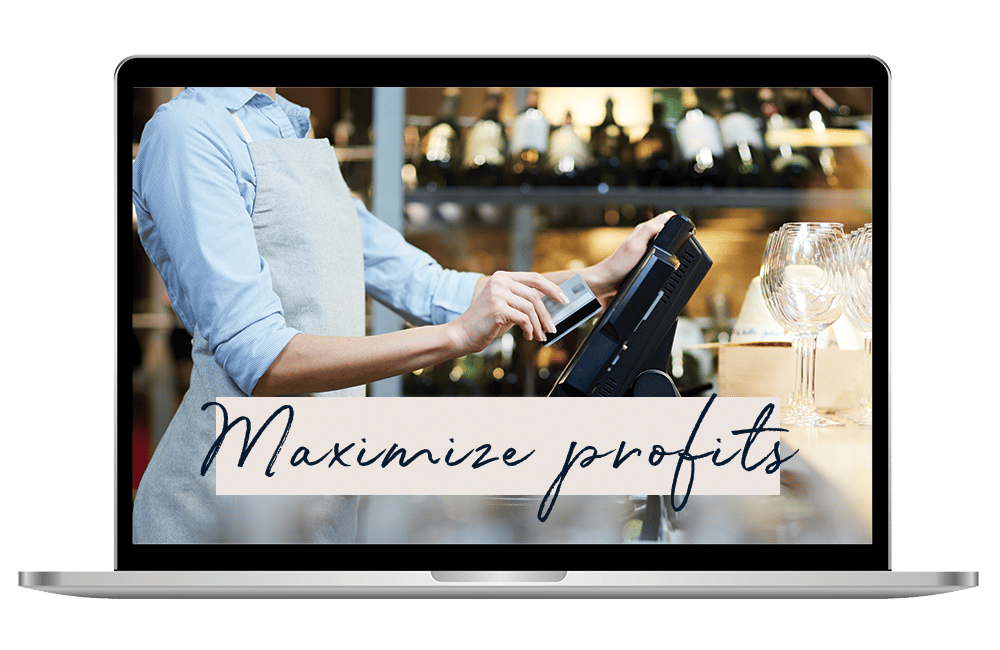
The three costly mistakes you could unknowingly be making?
Find out in this FREE guide and restaurant assessment specifically designed to reveal the unexpected hurdles standing between you and exponential business growth.
Thank You To Our Sponsors
Increase restaurant sales, optimize guest throughput, and boost customer engagement all on one seamless platform.
Request a demo!
Top equipment brands, extensive inventory, everyday low prices, and 60 years serving independent food service operators.
For a limited time only, popmenu is offering our listeners $100 off your first month plus an unchanging lifetime rate.
Request a DEMO:
Did You Know That 7 out of 10 Adults Dine Out To Celebrate Birthdays?
You Can Easily Capture This Lucrative Business!
Want to become a podcast sponsor?
Please get in touch with Roger at roger@restaurantrockstars.com
